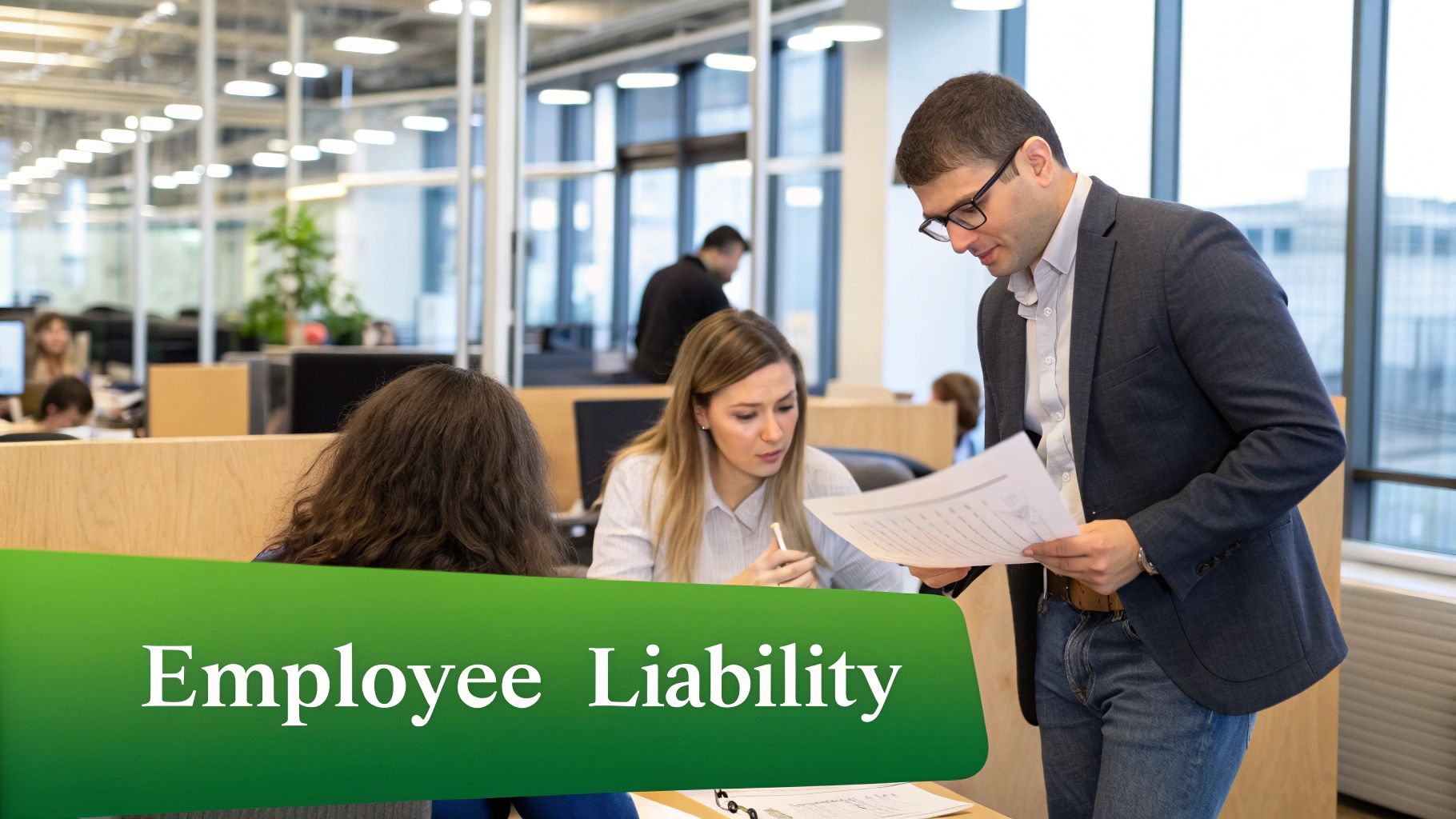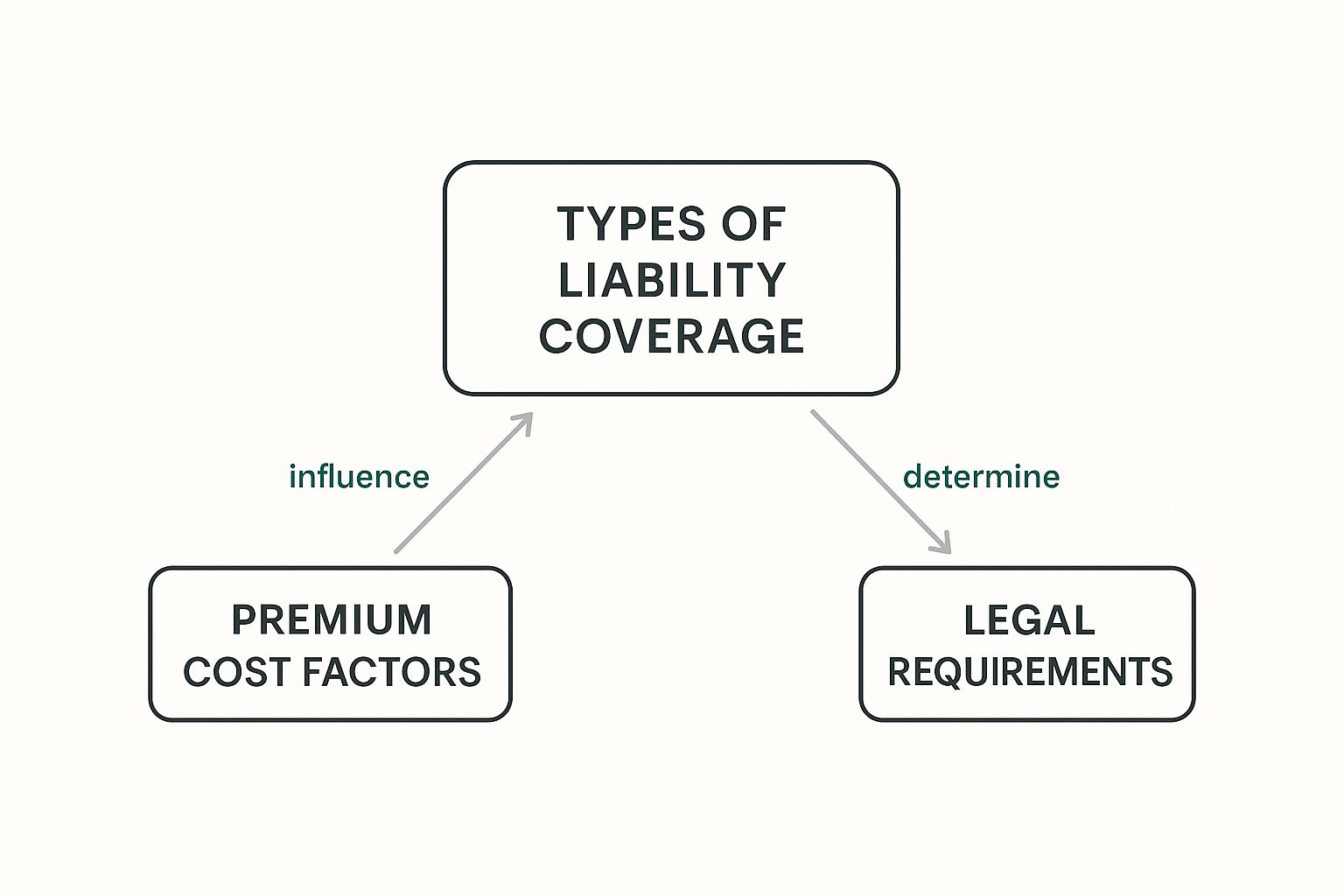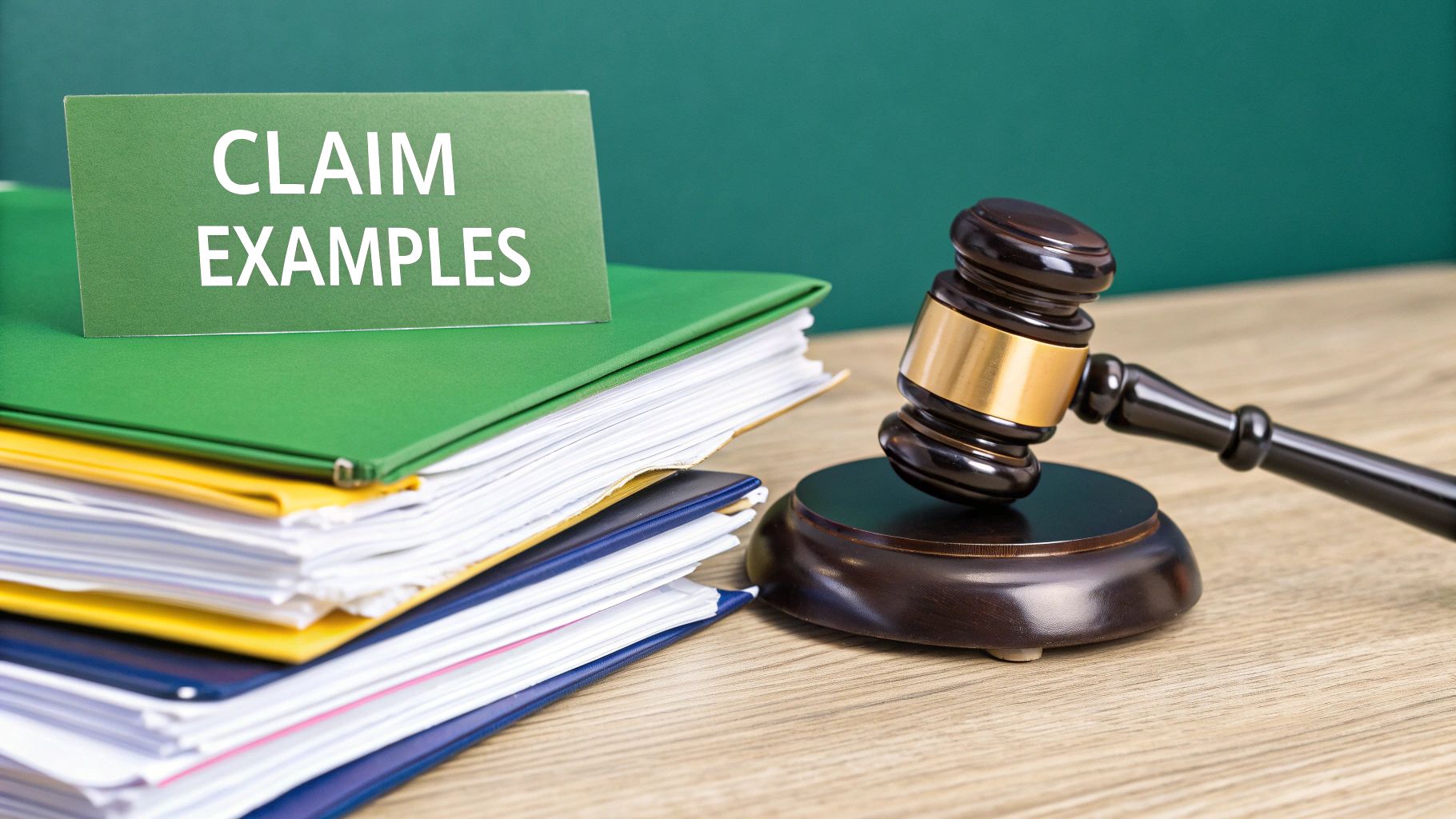Understanding Employee Liability Coverage Without The Jargon
Think of liability insurance for employees as a silent guardian, protecting your business from the unexpected storms of workplace disputes. Imagine Sarah, a restaurant owner diligently navigating the complexities of running her business. One day, a dismissed employee files an age discrimination lawsuit. Sarah, believing she'd followed all the rules, is suddenly facing a legal battle.
This scenario, unfortunately, isn't uncommon. Many small businesses find themselves entangled in six-figure lawsuits stemming from what initially seemed like minor workplace disagreements. This underscores the critical need for adequate protection. For further reading on general liability, check out this helpful resource: Read also: General Liability Meaning
Why Your Usual Business Insurance Isn't Enough
Your standard business insurance policy, like a sturdy roof, protects you from common perils like accidents and property damage. But what about the cracks that can appear in employee relationships? These often fall outside the scope of general liability.
For instance, if a customer slips and falls in your store, your general liability insurance likely has you covered. But if an employee sues you for wrongful termination, you're in a different territory. That’s where Employment Practices Liability Insurance (EPLI) comes in. This specialized liability insurance for employees acts as a safety net for these specific situations. And its importance is growing. The EPLI market is projected to reach $4.94 billion by 2031, with premium increases stabilizing in recent years. Discover more insights
Intentional Harm vs. Honest Mistakes
It's important to distinguish between deliberate actions and unintentional missteps. Intentional harm, such as outright discrimination, is rarely covered by any insurance policy. EPLI, however, focuses on protecting your business from the consequences of honest mistakes.
Consider a scenario where you unintentionally overlook a qualified candidate due to unconscious bias. This could result in a discrimination claim, even if you had no ill intentions. EPLI can help cover legal expenses and potential settlements in such cases.
Recognizing the Warning Signs
Knowing when your business might need liability insurance for employees is like recognizing the early signs of a storm. Rapid expansion, high employee turnover, or a history of workplace disputes can all indicate increased risk. Furthermore, adopting new technologies, such as AI-powered hiring tools, can introduce new potential liabilities. These are all signals to evaluate your need for EPLI coverage to safeguard your business from potentially crippling legal challenges.
What's Actually Covered (And The Surprises That Aren't)
This infographic gives you a visual overview of how different types of liability coverage connect, what factors influence premium costs, and which legal requirements shape what coverage you actually need. Notice how these three elements are all linked together. The cost of premiums directly affects the types of coverage a business can afford, while legal requirements dictate the minimum necessary coverage to stay on the right side of employment laws.
Let's dive into what liability insurance for employees, particularly Employment Practices Liability Insurance (EPLI), actually protects. Imagine Tom, a tech startup founder. He believed he had adequate coverage. However, when a contractor sued him over a contract dispute, Tom discovered a painful gap in his policy. His EPLI didn't cover contractors, leaving him personally responsible for all the legal fees.
Discrimination, Termination, Harassment, and Retaliation
EPLI typically covers claims related to several key areas:
- Discrimination: This includes claims based on age, race, religion, gender, sexual orientation, and other protected characteristics.
- Wrongful Termination: If an employee believes they were fired illegally, EPLI can offer protection.
- Harassment: Coverage extends to claims of a hostile work environment, sexual harassment, or other forms of harassment.
- Retaliation: If an employee alleges they were punished for reporting illegal activity, like whistleblowing, EPLI can step in.
These are common situations where businesses can incur significant legal costs, even if they are ultimately found not guilty. EPLI helps minimize these financial burdens.
The Devil's in the Details: Understanding Exclusions
Just as crucial as knowing what's covered is understanding what isn't. Many policies have exclusions – specific situations or types of claims that are not covered. For instance, some policies exclude claims relating to wage and hour disputes or issues stemming from employee dishonesty. Grasping these exclusions is vital for a thorough risk assessment. For more on related topics, check out this helpful resource on Workers' Compensation for Small Business.
Policy Structures and Coverage Gaps
Different policy structures can lead to significant variations in coverage. Some policies provide comprehensive protection, while others are more limited in scope. Understanding these nuances is crucial to avoid unexpected gaps in your coverage. Tom's story, for example, underscores the importance of verifying whether your policy covers independent contractors or only full-time employees.
To help you compare different coverage options, we've compiled the following table:
Employee Liability Coverage Types Comparison
A detailed comparison of different liability insurance coverage options for employees, including what's covered, typical limits, and exclusions.
| Coverage Type | What's Covered | Typical Limits | Key Exclusions |
|---|---|---|---|
| Employment Practices Liability Insurance (EPLI) | Discrimination, Wrongful Termination, Harassment, Retaliation | $1 million to $5 million | Wage and hour disputes, employee dishonesty (can vary by policy) |
| Directors and Officers Liability Insurance (D&O) | Wrongful acts by directors and officers | $1 million to $10 million | Libel and slander, antitrust violations (can vary by policy) |
| Fidelity Bond | Employee theft or fraud | Varies depending on the bond | Intentional acts by the business owner, losses due to natural disasters (can vary by policy) |
This table highlights some key differences in coverage types, limits, and common exclusions. Be sure to consult with an insurance professional for specific details related to your business needs.
By understanding the complexities of liability insurance for employees, including the scope of coverage, exclusions, and variations in policy structures, you can make well-informed decisions to protect your business. This knowledge allows you to identify potential vulnerabilities and secure the coverage that truly meets your needs, preventing costly surprises down the line.
Navigating The Legal Maze: When Optional Becomes Essential
While Employment Practices Liability Insurance (EPLI) isn't legally required, the rules around employment are always changing. What was fine yesterday might be a legal headache today. Understanding this is key to protecting your business.
State Laws and Industry Risks
Employment law is like a patchwork quilt – each state has its own unique design. Some states offer employees more protections than others. On top of that, certain industries, like healthcare or finance, naturally carry higher risks because of the sensitive information they handle. Imagine a healthcare provider dealing with patient data. They're much more likely to face privacy lawsuits than, say, a retail store.
Think about gambling laws. Casinos are tightly regulated everywhere, but some states have even stricter rules. Employment law is similar. Your specific state and industry shape your company's legal vulnerability.
Changing Workplace Dynamics and Evolving Court Decisions
The modern workplace is constantly evolving, bringing new challenges and potential liabilities. Take social media, for instance. Harassment claims stemming from online interactions between employees, even outside of work, are on the rise. This adds a whole new layer of risk that didn't exist a few years ago. Similarly, using AI in hiring is raising concerns about bias and discrimination lawsuits.
Court decisions also have a huge impact. A single ruling can redefine workplace harassment or discrimination, setting new legal precedents that affect businesses across the country. These shifts can catch companies off guard if they haven't carefully assessed their risks.
Assessing Your Legal Risk Profile
Figuring out your specific legal risk profile is crucial for deciding if EPLI is right for you. Things like company size, industry, and what your employees actually do all contribute to your overall risk. A company with a large remote workforce, for example, faces different liabilities than a company with everyone in one office.
By considering your legal environment, the changing nature of work, and the potential fallout from employee lawsuits, you can make smart choices about EPLI. While it might not be mandatory, it can be a vital safety net against unexpected legal battles.
The Real Numbers: What You'll Pay Versus What You'll Face
Let's talk money. When it comes to liability insurance for employees, one of the biggest questions is always the cost. More specifically, how much will the insurance cost versus how much could a potential lawsuit cost? It’s a crucial balancing act.
Understanding Premium Drivers
What determines the price of your premiums? It's a bit like building a house. A bigger, more complex house costs more to build. Similarly, a larger company with more employees presents a larger risk to an insurer, which usually translates to higher premiums. The industry you’re in also matters. A construction company naturally faces different risks than a software company, impacting premiums.
Your company’s history with claims matters too. Think of it like your driving record. A clean record gets you better rates. In the business world, a positive claims history, combined with good HR practices like clear anti-harassment policies, can actually lower your premiums. These practices signal to the insurer that you’re actively working to minimize risk.
Budgeting and Return on Investment
Most businesses see liability insurance for employees as a regular operating expense, like rent or utilities. They budget for it annually as a key part of their risk management strategy. The true return on investment (ROI) becomes clear when a claim is made.
Imagine Lisa, a manufacturing business owner. She faced a $200,000 harassment claim. Suddenly, her annual $3,000 premium seemed like a small price to pay to avoid a potentially catastrophic financial hit. The insurance industry, including liability coverage, has seen its share of ups and downs globally. In the US, premiums are projected to rise roughly 11% each year through 2025, while combined ratios are expected to drop significantly. Discover more insights
The Hidden Costs of Going Bare
Operating without liability insurance for employees is a risky gamble. While skipping those premiums might look good in the short term, it exposes your business to potentially crippling financial consequences.
Legal defense costs alone can be staggering. Even if you’re found not liable, you could easily rack up $50,000 or more in legal fees before the case even goes to court. Factor in potential settlement costs or jury awards, and the financial impact could be devastating.
Managing Premiums and Maximizing Value
Smart premium management is about more than just finding the cheapest policy. It's about understanding your company’s risk profile, selecting appropriate coverage, and implementing proactive risk mitigation strategies. It's about getting true value for your money.
This includes carefully considering the financial stability of your insurance carrier. Can they handle a large claim? Do they have a reputation for responsive and supportive customer service when you need it most? Ultimately, liability insurance for employees is about protecting your business's future, not just ticking a box.
Modern Workplace Risks: AI, Remote Work, and Tomorrow's Problems
The modern workplace is changing rapidly. It's evolving so fast that traditional liability insurance for employees often misses the mark. New technologies and ways of working are creating risks that simply didn't exist before.
AI and the Potential for Bias
Think about the increasing use of artificial intelligence in hiring. AI promises to make hiring more efficient, but it also carries the risk of unintended bias. Imagine an AI system trained on data that reflects existing societal biases. That system could unintentionally discriminate against certain candidates, leading to discrimination claims. The U.S. Equal Employment Opportunity Commission (EEOC) is already looking at this issue. They're concerned about how AI might introduce discrimination into HR. Learn more about AI and discrimination claims.
Remote Work and the Blurring of Boundaries
Remote work adds another layer of complexity. The traditional workplace has dissolved. Now, work happens anywhere – at home, in coffee shops, across time zones. This blurring of boundaries makes it harder to define what constitutes a workplace incident.
What happens when an inappropriate comment is made during a virtual team-building event? Is that a workplace incident? These gray areas challenge traditional definitions of harassment and require a fresh look at liability insurance for employees.
The Gaps in Traditional Policies
Many companies are finding their current insurance policies aren't keeping pace with these digital risks. Traditional policies might not cover things like online harassment, AI-related bias claims, or incidents that happen outside the physical office. This can leave businesses exposed to unexpected legal issues and significant financial losses. For instance, a company using AI hiring software could face discrimination claims that their current liability insurance for employees simply doesn't cover.
Staying Ahead of the Curve: Proactive Risk Management
So, what can businesses do? They need to be proactive. Start by looking at the technology you're using. Where are the potential vulnerabilities? Are your remote work policies clear and comprehensive? And most importantly, does your liability insurance for employees address the unique challenges of a digital workplace?
Asking these questions and staying informed about the changing legal and technological landscape is crucial. It's how businesses can stay ahead of the curve and avoid costly legal battles. Addressing these modern challenges is essential to protecting your business in today's evolving work environment.
Smart Shopping: Finding Coverage That Actually Works
Choosing the right liability insurance for employees isn't a one-size-fits-all solution. It's more like finding the perfect suit – you need a tailored fit for your specific business needs. Imagine David, a manufacturer who learned this lesson the hard way. He initially opted for the cheapest policy he could find, thinking he'd snagged a bargain. However, when a discrimination claim arose, he discovered his coverage was woefully inadequate, leaving his business exposed. That "bargain" ended up costing him dearly.
Assessing Your Needs and Evaluating Carriers
Before you even start looking at policies, take a hard look at your business and the potential risks you face. This is your risk assessment. Think about factors like the size of your workforce, whether you have remote employees, or if you use AI tools like those from Amazon Web Services (AWS) in your hiring process. These all influence the kind of coverage you’ll need.
Once you have a grasp of your risks, you can begin evaluating potential insurance carriers. Don’t get dazzled by low premiums alone. The financial stability of the carrier is paramount. After all, what good is a policy if the company can't pay out when you need them? You want a partner you can rely on, not a company that might disappear when a claim arises. For those also concerned with online risks, understanding Cyber Liability Insurance Cost is also important.
Comparing Policies and Spotting Red Flags
With a few potential carriers in mind, it's time to delve into the specifics of their policies. Pay close attention to the coverage limits and exclusions. What exactly is covered, and more importantly, what isn't? Are there any hidden fees lurking beneath the surface? Be wary of policies that seem too good to be true. Excessively low premiums often signal significant limitations in coverage.
It's also crucial to understand the broader insurance market trends. For example, excess and surplus (E&S) premiums soared to over $45 billion in 2023, representing 35% of all liability premiums – a substantial jump from 26% in 2018. This growth underscores the increasing need for flexible risk management strategies as businesses look for broader coverage options. Learn more about these market dynamics.
Finally, be on the lookout for red flags. Vague policy wording, a slew of negative customer service reviews, or a history of denied claims should all raise concerns. These can be indicators of a carrier that may not be the right fit for your business.
Choosing the Right Partner for Your Business Future
Selecting liability insurance for employees is about more than just ticking a box. It's about forging a partnership with a company you can trust. Look for carriers with specialized knowledge in your industry, a strong commitment to customer service, and a proven track record of financial stability.
To help you in your evaluation process, we’ve compiled a table highlighting key criteria to consider:
The table below, "Insurance Carrier Evaluation Criteria," outlines key factors to consider when choosing an insurance provider. It helps you understand not just what to look for, but also why it’s important and how to spot potential problems.
| Evaluation Factor | Why It Matters | How to Assess | Red Flags |
|---|---|---|---|
| Financial Strength | Ensures the carrier can pay out claims | Check independent rating agencies like A.M. Best | Ratings below "A-" |
| Coverage Options | Must address your specific risks | Review policy details and compare coverage limits and exclusions | Vague policy language, limited coverage for common claims |
| Customer Service | Support during the claims process is essential | Read online reviews, ask for referrals | Negative reviews, unresponsive customer service |
| Claims History | Indicates the carrier's willingness to pay claims | Request data on claims processing time and payout rates | High rate of denied claims, lengthy processing times |
By thoroughly assessing your needs, carefully evaluating potential carriers, and asking the right questions, you can find the right liability insurance for employees and gain true peace of mind, allowing you to focus on what matters most – running your business.
Your Action Plan: From Decision To Protection
Now that you understand why liability insurance for employees is so important, let's map out how to get the right coverage. Think of it like planning a road trip: you wouldn't just hop in the car and start driving, would you? You'd plan your route, pack accordingly, and make sure the car is in good shape. Similarly, securing the right insurance involves a few key steps, from assessing your needs to managing your policy effectively.
Step 1: Assess Your Risk Profile
Before you start browsing insurance options, it’s crucial to understand your specific needs. This is like checking the terrain before your road trip—are you driving through mountains, desert, or cityscapes? Each environment requires different preparations. Similarly, different businesses have different risk factors. Consider these points:
- Company Size: A larger team often means a higher potential for incidents, just like a bigger carpool increases the chances of someone needing a bathroom break.
- Industry: Certain industries, such as construction or healthcare, naturally carry higher risks, like driving on a winding mountain road versus a straight highway.
- Workplace Dynamics: A history of workplace disputes is a red flag, like a car with a history of breakdowns. High employee turnover can also signal potential issues.
- Technology Use: Using AI-powered hiring tools or having remote work arrangements can introduce new types of liability, like adding a roof rack to your car—it's useful, but it also changes the vehicle's dynamics.
This initial assessment helps you tailor your liability insurance for employees to your unique situation, just like packing the right gear for your road trip.
Step 2: Research Insurance Carriers
Don't just grab the first insurance quote you see. It's like choosing the first roadside motel you spot—it might be convenient, but is it the best option? Take the time to research different insurance carriers, focusing on these factors:
- Financial Stability: You want a carrier that can handle a significant claim, like having a reliable spare tire in your trunk. Check independent rating agencies like A.M. Best for insights into a carrier's financial strength.
- Specialized Expertise: Some carriers specialize in specific industries or types of coverage. This is like choosing a mechanic who specializes in your type of car.
- Customer Service: Responsive customer service is essential, especially if you need to file a claim. It's like having roadside assistance—you want to know someone will pick up the phone when you need help.
Step 3: Compare Policies and Coverage
Once you’ve identified a few potential carriers, it’s time for a detailed policy comparison. Think of it like comparing different hotels at your destination—you'd consider factors like price, amenities, and location. When reviewing insurance policies, look at:
- Coverage Limits: This is the maximum amount the policy will pay out – like the maximum capacity of your car's gas tank.
- Exclusions: These are specific situations or claims that are not covered—like roadside assistance that doesn’t cover flat tires.
- Premiums and Deductibles: Balancing premiums (the cost of the policy) and deductibles (what you pay out-of-pocket before coverage kicks in) is like choosing between a fuel-efficient car and a gas-guzzler.
Don’t hesitate to ask questions and get clarification on anything you’re unsure about. It’s better to be thorough upfront than to encounter surprises down the road.
Step 4: Implement and Manage Your Policy
After purchasing a policy, it’s important to implement and manage it effectively. This is like having a map and knowing how to use it.
- Communicate: Explain the coverage to your employees and management team. This is like sharing the itinerary with everyone in the car.
- Establish Procedures: Develop clear procedures for handling potential claims, just like having a plan for what to do if you get a flat tire.
- Review Regularly: Review your policy annually or when your business undergoes significant changes. This is like checking your car’s oil and tire pressure regularly to ensure everything is running smoothly.
By following these steps, you can confidently navigate the process of getting liability insurance for employees. It’s like planning a successful road trip—with careful preparation, you can protect your business from the financial and reputational damage of workplace disputes and arrive at your destination safely.
Ready to protect your business? Get a personalized quote from Wexford Insurance Solutions today! Learn more about Wexford's comprehensive business insurance solutions.
 Understanding General Liability Meaning: A Quick Guide
Understanding General Liability Meaning: A Quick Guide Management Liability Coverage: Essential Guide for Business Owners
Management Liability Coverage: Essential Guide for Business Owners









